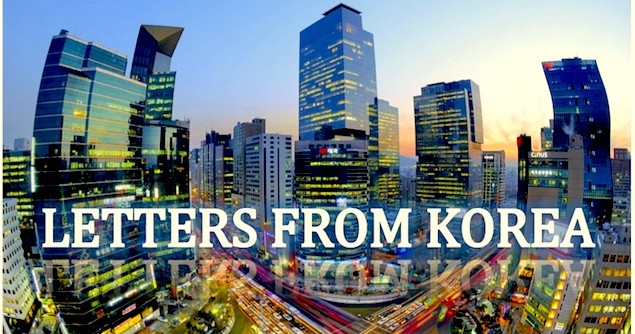Korean Notebook

As the aircraft descends through the clouds over the vast metropolis of Korea’s leading city, it’s hard to make out the ground through the off-white haze that shrouds the layers of concrete. This is what we used to call ‘Los Angeles type smog’ and today, the sinking sun and the Han River are barely visible as we approach the runway. There is little green, except atop a handful of mountain peaks that are above the pollution.
On the ground, it’s easy to see why. Seoul, pleasant in parts with many fine buildings and attempts to introduce greenery and improve the environment, is nevertheless a concrete jungle. The official population of Seoul is a mere ten million, but its vast urban conurbation in which it sits houses 50 million people, or half the country’s total population. Crossing the city from the south to the north bank is a hideous experience; unless you are in a bus with more than six people, or on the subway.
With my limited eyesight, I was nervous about the subway, but not only are the trains clean, frequent, inexpensive and accessible—with several entrances to any one station—but the staff are exceptionally helpful. It’s best to buy a card for about $3, load it up with some cash and then make multiple journeys as you wish.
Still, the authorities are trying to control urban sprawl so the government is moving the political capital out of Seoul and into the bush, Canberra-style. Last month, it announced that by 2020, the country’s seat of government would be at Sejong, 120 km to the south, in a hilly landscape that has many similarities to Canberra.
Between now and then, this once sleepy hollow will be a vast building site of cranes, steel, glass and concrete, eventually housing 500,000 people; most of them bureaucrats. The president will relocate, at least for some of the time, but it’s not finally decided whether the politicians will follow. And even if the National Assembly does not move, there are likely to be sittings in Sejong.
Estimates of the costs vary wildly from $45 billion to double that, but it will still be a bonus for the construction and steel industries.
Diplomats are less than enthralled. Many are scratching their heads about how they are going to manage the transition and the additional cost of splitting staff between Seoul and Sejong. Two East European diplomats I met expected to have to commute between the two. The Australian embassy, which also serves Pyongyang and Mongolia, is already understaffed by any sensible international comparison, and South Korea is our fourth-largest trading partner.
This is not a ‘might-happen’ project. Over 100,000 public servants have already arrived and meetings are already being held in the gleaming new buildings. One diplomat, who had to drive up there to attend such a meeting, said he had to stand in the corridor before the meeting started because there was nowhere to sit.
Another question arises in the event that reunification takes place. Even if such a possibility were on the horizon now, it would—by specialists’ estimates—take at least five years to negotiate an agreement. And that agreement would likely not involve the creation of a common capital, as happened between the two Germanys in Berlin, with separate capitals continuing for some time.
Reunification is, however, still on the agenda and I was fortunate to be a special guest at a high-level conference on its cost and benefits to neighbouring countries, China, Japan, Russia and the United States.
President Park Geun-hye has talked up reunification since being elected last year, and officials and commentators have spoke of the probability of this creating a “bonanza for everyone”.
At the Conference, the Chinese seemed the most enthusiastic and may well have the most to gain. But when asked if that was the case and why Beijing was not using its influence on Pyongyang to get the North Koreans to the table, a leading Chinese professor replied adroitly that since China had joined in sanctions on the nuclear issue, it had lost its influence.
The most negative speaker was from the Russian Academy of Sciences in Moscow who conceded that there may, under certain circumstances, be economic benefits to her country, but indicated that the Kremlin had strategic worries—not least because of the role of the United States in a unified Korea.
A full report of this conference will appear in this space shortly.
Colin Chapman, president of the AIIA in NSW, is leading a delegation visiting Seoul for a series of meetings with Korean officials and think tanks.


